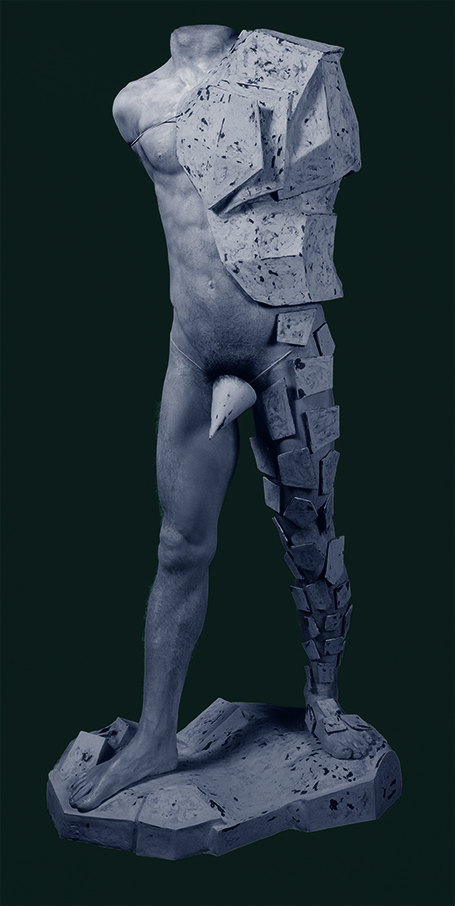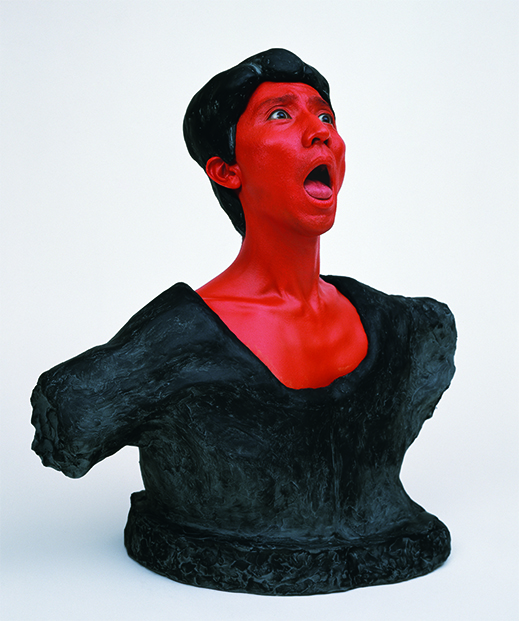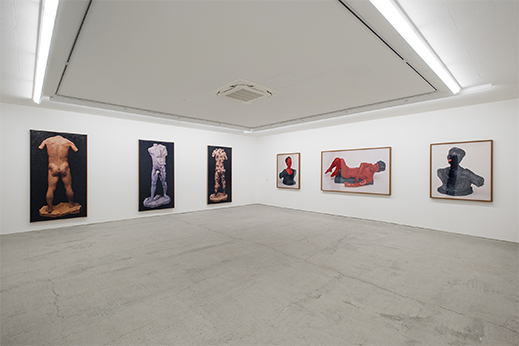 |
Focus features two in-depth reviews each month of fine art, architecture and design exhibitions and events at art museums, galleries and alternative spaces around Japan. The contributors are non-Japanese residents of Japan. |
|
|
 |
 |
 |
Behind the Mask: The Yasumasa Morimura Museum
Christopher Stephens |
 |
|
Yasumasa Morimura, The Birth of Man (1988) |
Recent years have seen a number of new museums established by living Japanese artists to showcase their lesser known works and secure their legacy. Among these are the Tadanori Yokoo Museum of Contemporary Art, occupying a former wing of the Hyogo Prefectural Museum of Art in Kobe, and the Yayoi Kusama Museum, housed in a sleek five-story building in Tokyo's Shinjuku Ward. This select group is now joined by Yasumasa Morimura (b. 1951), whose Morimura@Museum (M@M) opened in Osaka in early November.
Located in a former industrial facility in the mixed-use neighborhood of Kitakagaya, once a prosperous shipbuilding area, the museum retains the original look of the building. Inside, however, the structure has been renovated into a 400-square-meter space that includes two galleries, a cinema, a library/salon, and a gift shop. The unassuming atmosphere is very much in keeping with Morimura's personal aesthetic. Despite his international fame, the artist is still based in the working-class neighborhood of Tsuruhashi, not far from the house where he was born and lived in until he was well into his thirties. (Some of the items on offer in the museum's gift shop are displayed on old green tea crates, remnants of the shop Morimura's parents ran on the first floor of the house.)
 |
|
|
Exterior view of Morimura@Museum. Photo by Kazuo Fukunaga |
Set to host two seasonal exhibitions a year, the museum is currently holding its inaugural show, which focuses on some of Morimura's earliest efforts. After garnering attention for a photographic re-creation of Vincent van Gogh's Portrait with Bandaged Ear in 1985, Morimura made seven more self-portraits for a solo exhibition titled Mon amour violet et autres (My Violet Love and Others), which was held at Gallery Haku in Osaka in 1986. The current show, Did You See Mon amour violet et autres?: Yasumasu Morimura's Alternative View of the 1980s, features a reproduction of this earlier exhibition in one gallery.
|
 |
|
|
|
Yasumasa Morimura, Portrait (L'homme qui marche I) (1986)
|
Three of the works were inspired by Rodin's L'homme qui marche (The Walking Man), a nude male figure depicted in mid-stride. The first, Portrait (L'homme qui marche I), shows Morimura from the front positioned at a slight angle with his feet planted firmly on a stone pedestal. Like the original, he is armless and headless -- an effect created by covering these sections of his body with black cloth. The work deviates from Rodin's in that the left side of Morimura's torso is covered with a rocky angular appendage and his left leg is dotted with small hard rectangles. This seems to suggest that he is in the process of turning from stone to flesh and blood. And whereas the private parts of Rodin's figure are indistinct, Morimura adds a comic touch by covering himself with what looks like a pointed party hat. The other two works in the trilogy capture the artist from behind. In the first, he is covered from neck to toe with small pieces of stone. But by the second, he has turned into a smooth, muscled model of a man.
The Gallery Haku show also included another Rodin-inspired trilogy. The first and third of these works, Portrait (Red I) and Portrait (Black), are patterned after The Scream (1886), a bronze bust portraying a man with his head angled upward letting out an anguished cry. In Morimura's versions, the artist is clad in a low-necked garment and matching pompadour with a rough metallic texture. In contrast, his skin, bright red in the first piece and deep black in the second, is smooth and shiny. And while Rodin's figure has a truly heart-wrenching expression, accentuated by the slight leftward tilt of his head, Morimura's erect neck and pink tongue (a feature of both versions) make him look more hopeful than pained.
 |
|
Yasumasa Morimura, Portrait (Red I) (1986) |
The second work in the series, Portrait (Red II), centers on a full-body shot of Morimura lying on a pedestal with his legs bent in the air. Completely red except for his black hair, Morimura stares with his mouth agape and his right hand reaching toward his left arm, which lies stiffly at his side in a white bandage spattered with red paint. As with the first trilogy, we seem to be witnessing a kind of transformation, as a living being breaks out of hard stone. In the summer of 1988 these three works were shown at the Venice Biennale, winning Morimura his first international audience.
One of the current show's major revelations is that prior to finding his subject matter in himself, Morimura made abstract prints and imagistic photographs. One example, City on Table: Two Monuments (1984), is part of a series of black-and-white pictures in which dishes and cutlery are cleverly arranged on a tabletop to resemble architectural structures. Lacking the hallmarks of his later self-portraits, these pieces are clearly part of a transitional phase, but like Morimura's later work, they are peppered with sly humor.
 |
|
Yasumasa Morimura, City on Table: Two Monuments (1984)
|
All of the faces in Morimura's art invariably belong to the artist himself. Take, for instance, his 1989 work Portrait (Nine Faces), Morimura's take on Rembrandt's The Anatomy Lecture of Dr. Nicolaes Tulp. As the title suggests, the doctor, his seven students, and the corpse are all played by Morimura. (As it happens, this work also marked the artist's first foray into computers.) This makes The Birth of Man (included in the current exhibition) a true anomaly in Morimura's career. A collaboration with Tamame Akamatsu, the picture was created for a gallery show on the theme of "man," and is loosely based on Botticelli's The Birth of Venus. Consisting of five ornately costumed characters (Morimura can be seen at top left, Akamatsu at top right), the wall-sized photograph, embellished with acrylic paint, is a stunning composition filled with color and eye-catching details. It is all the more impressive when we realize that all of the participants actually occupied the same space at the same time.
The exhibition's charm lies in the handmade quality of this and other early works, dating from a time when technical limitations called for imaginative solutions. More than 30 years on, Morimura is still bursting with creativity, and his museum promises to show us things that we have never seen before.
 |
|
Exhibition view of Did You See Mon amour violet et autres?: Yasumasu Morimura's Alternative View of the 1980s.
Photo by Kazuo Fukunaga
|
All images © Yasumasa Morimura, courtesy of Morimura@Museum |
 |
Did You See Mon amour violet et autres?:
Yasumasu Morimura's Alternative View of the 1980s |
| 3 November 2018 - 27 January 2019 |
|
 |
| Morimura@Museum |
| Hours: 12 - 6 p.m. Friday through Sunday; closed 25 December 2018 - 10 January 2019
|
|
 |
 |
Christopher Stephens
Christopher Stephens has lived in the Kansai region for over 25 years. In addition to appearing in numerous catalogues for museums and art events throughout Japan, his translations on art and architecture have accompanied exhibitions in Spain, Germany, Switzerland, Italy, Belgium, South Korea, and the U.S. His recent published work includes From Postwar to Postmodern: Art in Japan 1945-1989: Primary Documents (MoMA Primary Documents, 2012) and Gutai: Splendid Playground (Solomon R. Guggenheim Museum, 2013). |
|
 |
|